Press Release
Service Facilities Honored With Federal Energy and Water Management Awards
Two national wildlife refuges on opposite coasts received 2010 Federal Energy and Water Management Awards from the Department of Energy for their innovative, sustainable designs of visitor centers and administrative headquarters. The two U. S. Fish and Wildlife Service winners were Parker River National Wildlife Refuge in Massachusetts and Inland Northwest National Wildlife Refuge Complex, located on Turnbull National Wildlife Refuge in Washington. The winners were announced during an awards ceremony on October 7 in Washington, DC.
The Federal Energy and Water Management Awards recognize individuals, groups and agencies for their outstanding contributions in the areas of energy efficiency, water conservation and the use of advanced and renewable energy technologies at federal facilities.
The Parker River Refuge Visitor Center and Administrative Headquarters ( http://www.fws.gov/northeast/parkerriver/) was built in 2003 as a model of sustainable design, complete with passive solar techniques, super-insulation of the building envelope, high-efficiency lighting, and a geothermal open loop ground source heat pump that reduces energy use by 41 percent as compared to a traditional office building. Although the land around the building was restored to its natural habitat, highly corrosive groundwater caused the geothermal system to fail. Parker River Refuge was undeterred.
The refuge transformed the setback into a success by installing a solar photovoltaic (PV) system that generates about 48 megawatt-hours per year and supplies 33 percent of the building's electrical needs. The building also converted from geothermal to a natural gas-fired ENERGY STAR heating system. These measures saved more than 115 million Btu and 31 metric tons of greenhouse gas emissions while reducing energy costs by more than one third in FY2009. Even greater energy savings are expected for FY2010, now that the PV system has had a full year of operation. More than 255,000 visitors come through the center each year and learn about the system's performance by visiting the interactive display.
The 6,957 square-foot headquarters and visitors center at Inland Northwest National Wildlife Refuge Complex, Cheney, Washington, incorporates numerous energy-saving strategies, including super-insulation, a cool roof, energy-efficient LED lighting with occupancy sensors, triple-paned low-emissivity windows, optimal building orientation, and local stone and concrete to enhance thermal mass and help maintain comfortable temperatures. The main building uses a 14.35-ton geothermal heat pump with an overhead electric forced-air system for heating and cooling, a 4.9- kilowatt grid-tied solar photovoltaic array for electricity and a flat-plate roof-mounted solar collector system for hot water.
To conserve water, the grounds were landscaped with native plant species; low-flow plumbing fixtures were used; and bioswales were installed for parking lot runoff. Most of the building materials have a high recycled content, and more than half of the construction waste was recycled. The efficient design reduces energy use by about 32 percent as compared to an average building; 15.5 megawatt-hours of renewable power save at least 10 metric tons of greenhouse gas emissions annually.
The visitor area of the new headquarters will include information describing the sustainability and energy efficiency of the buildings. Turnbull National Wildlife Refuge (http://www.fws.gov/turnbull/) welcomes about 49,000 visitors annually and offers recreational and educational opportunities year-round.
The Service is committed to reducing the carbon footprint of its facilities and becoming carbon neutral by 2020, as outlined in its recently finalized climate change climate change
Climate change includes both global warming driven by human-induced emissions of greenhouse gases and the resulting large-scale shifts in weather patterns. Though there have been previous periods of climatic change, since the mid-20th century humans have had an unprecedented impact on Earth's climate system and caused change on a global scale.
Learn more about climate change strategy ( http://www.fws.gov/home/climatechange/strategy.html).
The Federal Energy and Water Management Awards recognize individuals, groups and agencies for their outstanding contributions in the areas of energy efficiency, water conservation and the use of advanced and renewable energy technologies at federal facilities.
The Parker River Refuge Visitor Center and Administrative Headquarters ( http://www.fws.gov/northeast/parkerriver/) was built in 2003 as a model of sustainable design, complete with passive solar techniques, super-insulation of the building envelope, high-efficiency lighting, and a geothermal open loop ground source heat pump that reduces energy use by 41 percent as compared to a traditional office building. Although the land around the building was restored to its natural habitat, highly corrosive groundwater caused the geothermal system to fail. Parker River Refuge was undeterred.
The refuge transformed the setback into a success by installing a solar photovoltaic (PV) system that generates about 48 megawatt-hours per year and supplies 33 percent of the building's electrical needs. The building also converted from geothermal to a natural gas-fired ENERGY STAR heating system. These measures saved more than 115 million Btu and 31 metric tons of greenhouse gas emissions while reducing energy costs by more than one third in FY2009. Even greater energy savings are expected for FY2010, now that the PV system has had a full year of operation. More than 255,000 visitors come through the center each year and learn about the system's performance by visiting the interactive display.
The 6,957 square-foot headquarters and visitors center at Inland Northwest National Wildlife Refuge Complex, Cheney, Washington, incorporates numerous energy-saving strategies, including super-insulation, a cool roof, energy-efficient LED lighting with occupancy sensors, triple-paned low-emissivity windows, optimal building orientation, and local stone and concrete to enhance thermal mass and help maintain comfortable temperatures. The main building uses a 14.35-ton geothermal heat pump with an overhead electric forced-air system for heating and cooling, a 4.9- kilowatt grid-tied solar photovoltaic array for electricity and a flat-plate roof-mounted solar collector system for hot water.
To conserve water, the grounds were landscaped with native plant species; low-flow plumbing fixtures were used; and bioswales were installed for parking lot runoff. Most of the building materials have a high recycled content, and more than half of the construction waste was recycled. The efficient design reduces energy use by about 32 percent as compared to an average building; 15.5 megawatt-hours of renewable power save at least 10 metric tons of greenhouse gas emissions annually.
The visitor area of the new headquarters will include information describing the sustainability and energy efficiency of the buildings. Turnbull National Wildlife Refuge (http://www.fws.gov/turnbull/) welcomes about 49,000 visitors annually and offers recreational and educational opportunities year-round.
The Service is committed to reducing the carbon footprint of its facilities and becoming carbon neutral by 2020, as outlined in its recently finalized climate change climate change
Climate change includes both global warming driven by human-induced emissions of greenhouse gases and the resulting large-scale shifts in weather patterns. Though there have been previous periods of climatic change, since the mid-20th century humans have had an unprecedented impact on Earth's climate system and caused change on a global scale.
Learn more about climate change strategy ( http://www.fws.gov/home/climatechange/strategy.html).


